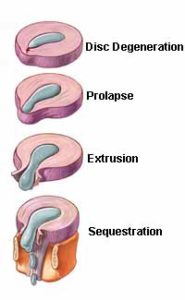Not all leg pain comes from the back, but when a nerve is pinched or irritated in your lower spine, it can cause very serious lower back and/or leg pain, as well as tingling, numbness, and weakness. This is called Sciatica because it is caused by irritation to the sciatic nerve which runs from the lower back to the feet. The irritation can be from a simple joint strain, or, it may involve a herniated disc.
Normally, a healthy spinal disc is strong and resilient to stretching, twisting, compression, and general back strain. After too much stress on your back, the disc begins to break down or degenerate. This is a gradually progressive condition although the pain and other symptoms can begin very suddenly, especially after heavy lifting.
Usually it starts with a little wearing out of the outer fibers of the disc and the soft inner part bulges outward. This is called a bulged disc. In time if this progresses it becomes a prolapsed disc. Eventually it may become an extrusion that protrudes beyond the outer disc and finally a sequestration when the piece of disc material breaks off from the rest. Each stage is worse than the one before, causing more pressure to the nerves and more likely to have more serious symptoms of back and/or leg pain.
The good news is, Chiropractic Adjustments have been proven to help all the stages of herniation. (Leemann S, et al, reporting in the Journal of Manipulative Physiological Therapeutics, 2014.) An experienced Chiropractor will do a thorough consultation and a full orthopedic examination of your spine. X-rays may be ordered to check for alignment and make sure there are no other pathologies of the spine. Chiropractors are not able to order MRIs (Magnetic Resonance Imaging) but they are usually not needed to begin Chiropractic care. If an MRI is needed, the Chiropractor will send a note to your Medical Doctor recommending it. Treatment begins with gentle maneuvers to gradually increase mobility in the restricted areas of the spine while being sure not to irritate any of the affected discs. There will be suggestions for home such as icing, stretching and strengthening exercises, and learning to avoid certain positions.



